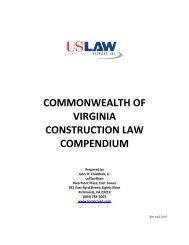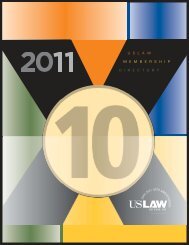state of oklahoma compendium of construction law - USLAW ...
state of oklahoma compendium of construction law - USLAW ...
state of oklahoma compendium of construction law - USLAW ...
You also want an ePaper? Increase the reach of your titles
YUMPU automatically turns print PDFs into web optimized ePapers that Google loves.
Most <strong>of</strong> the cases in this area are in the context <strong>of</strong> environmental problems, such as waterpollution or land deformation. However, in the <strong>construction</strong> context the rule would probably alsobe applied. It is likely that if the cost <strong>of</strong> repairing the defect is grossly disproportionate to theloss in value <strong>of</strong> the property, the damages awarded would be the diminution in value, in order toprevent economic waste. For example, the court, in State ex rel. Burk v. Oklahoma City, 556P.2d 591, 595 (Okla. 1976) (quoting State ex rel. Burk v. Oklahoma City, 522 P.2d 612, 621(Okla. 1973)), <strong>state</strong>d that, “equity will not insist on an absolute and literal restoration <strong>of</strong> theparties to status quo where it would be purposeless, useless, and foolish.”Comment [KM3]: The original quote wasciting a different case.14. PAY IF PAID CLAUSESThere are no true “pay-if-paid” Oklahoma cases, but one federal court decision suggests thatOklahoma would follow the general rule <strong>of</strong> courts looking with disfavor upon contractualprovisions conditioning payment upon some future event such as payment by the project owneror general contractor. The court will likely not find that a condition precedent to payment existsunless required to do so by plain and unambiguous language in the contract. See Byler v. GreatAm. Ins. Co., 395 F.2d 273 (10th Cir. 1968) (applying Oklahoma <strong>law</strong>).Pay-when-paid clauses are generally enforceable for a reasonable length <strong>of</strong> time after the dateupon which payment should have been made to the party relying on the clause. These clausesare designed to allow delay <strong>of</strong> payment for a reasonable time to allow for a fair opportunity forthe party to collect the earnings from the owner or general contractor. These provisions do notshift the credit risk or affect one‟s obligation to pay. See Byler, 395 F.2d 273 and Moore v.Cont’l Cas. Co., 366 F.Supp. 954 (W.D. Okla. 1973).For public projects, Okla. Stat. tit. 61, § 224 is a statutory pay-when-paid clause providing a timelimit for payment to subcontractors, sub-subcontractors, and material suppliers. Under thatprovision, if they have performed in accordance with their contract, they are entitled to receivepayment no later than ten calendar days after the prime contractor receives its correspondingpayment.15. FLOW DOWN/FLOW THROUGH CLAUSEFlow-down clauses provide that all duties and obligations the contractor owes the owner areowed by the subcontractor as well. Flow-down provisions are generally accorded validity, butcourts vary on whether they will be enforced fully according to their terms. These clausesgenerally incorporate the technical provisions and specifications without a problem, but courtsare <strong>of</strong>ten reluctant to enforce general flow-down provisions when it is not entirely clear what theparties actually intended or when the prime contract provision doesn‟t fit the circumstances <strong>of</strong>the subcontract. Exculpatory, or liability relieving, provisions are generally construed narrowlyor denied validity at all where there are inconsistencies between the prime and the sub contract.If you want a flow-down clause to be enforceable, it must be clearly <strong>state</strong>d within the contract.Oklahoma has not directly addressed the issue, but the United States District Court in Kansas hasfound that flow-down clauses are upheld when they are plain and unambiguous. If there is anyambiguity, the contract or clause therein is construed against the drafter. See United TunnelingEnters., Inc. v. Havens Constr. Co., Inc., 35 F. Supp. 2d 789 (D. Kan. 1998).11





